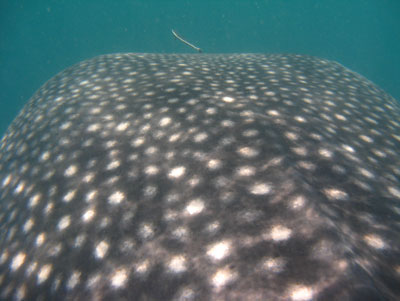Swimming with whale sharks
My wife, Gail, and I are both snorkelers, big time, and had read about divers swimming with whale sharks. We had the opportunity for such an experience during an eight-day tour of the Philippines in March ’09.
Whale sharks are not mammals like whales but are, instead, fish, belonging to the shark group. However, whale sharks are not predators; they feed mostly on plankton sieved through their gills as they swim. It is the largest fish in the world, growing to over 40 feet and weighing some 39 tons.
Local fishermen in the small coastal fishing town of Donsol, located on the west coast of the most southerly end of the island of Luzon, had long been aware of the numbers of whale sharks in the area, but it was not until 1998, when a team of foreign divers visited the area, that reports were publicized for the first time. Soon after, poachers and hunters swarmed in. The government was quick to react, declaring it a protected species.
From February to June, when the sharks migrate to feed on the annual plankton bloom, this small town of 30,000 becomes a busy place as visitors arrive from all over the world. Local fishermen become guides and whale shark spotters.
The morning of our encounter, we boarded a small boat with a narrow hull and an outrigger-stabilizer on each side. These local boats each have a capacity of six passengers and a crew of six. Our crew included our guide and a spotter.
As soon as a whale shark was seen, the helmsman began maneuvering toward the dark mass below the surface as our guide whispered for us to get ready. Anxiously, we sat on the edge of the boat, put on fins, adjusted face masks and awaited the guide’s nod to jump in. It came and we launched ourselves into the water behind the guide.
The first time was breathtaking, seeing the huge shark coming toward us with its four-foot-wide mouth agape. By positioning ourselves above it, we were close enough to touch the two dorsal fins on its back and two pectoral fins on its sides. But, of course, while it’s tempting to touch, it’s verboten. We tried frantically to keep up with the gentle monster, but it soon slipped away.
Each of the nine sharks we encountered acted distinctly differently. Some swam slowly enough that we could keep pace for a short while; others cruised faster, passing by us within seconds. One banked to the right, beginning a plunge which gave us a thrill. Our favorite turned and looked us in the eye as if to say, “What are you doing here?”
Encounter rules dictate that boats can stay out for three hours only. One boat is allowed per fish, with a limit of six people allowed to interact at one time.
Whale shark watching costs about $70 for two and is even less expensive per person when more people share the boat. As our experience was part of a tour on which we were guests* of the Philippines Department of Tourism, the cost of our outing was covered.
For whale shark encounters and other Donsol activities, contact Edith Batalla of EDB Tours (c/o Emma’s Appartelle, Gogon, Legazpi City, Philippines; phone [63] 52-4808341 or e-mail lally200_99@yahoo.com).
We found it easy to travel in the Philippines because most Filipinos speak English in addition to Tagalog, their national language, and English is the official language for signs. We found everyone to be friendly and helpful.
For more information, contact the Philippine Tourism Center (556 Fifth Ave., New York, NY 10036; 212/575-7915, or visit www.experiencephilippines.ph).
LARRY TAYLOR
Fullerton, CA
*While ITN does not usually publish reports on sponsored trips taken by travelers outside of staff and Contributing Authors, we felt the unusual experience described by the above subscriber called for an exception. — Editor

